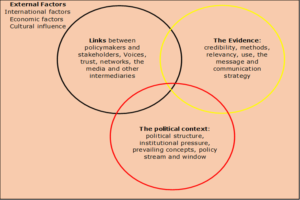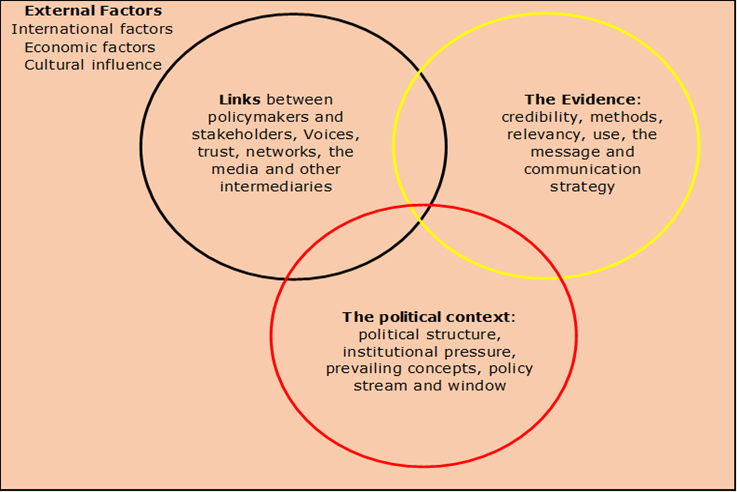Policy research and analysis are essential for informing and influencing policy decisions and actions of governments across the globe. However, policy research and analysis remain challenging due to the complexity, uncertainty, and dynamism of policy issues and political contexts. The main question remains;
How can policy researchers and analysts ensure that their work is relevant, rigorous, and useful for policymakers and stakeholders?
In the field of policy research, there are various models that have been developed to aid policymakers in making informed decisions and have an influence on policy issues. One such model is the RAPID model. RAPID stands for “Research and Policy in Development,” by the Overseas Development Institute (ODI, 2014) and it is an approach that seeks to facilitate the use of evidence in policy decision-making. It is a simple but comprehensive framework that covers the key stages and elements of policy research and analysis, from defining the problem and objectives to conducting research and analysis; to communicating and influencing policy decisions and actions. In this blog, we will explore the RAPID model in detail.
Analysing the External Factors
External factors are those that are outside of the control of policymakers but may have an impact on the policy development process or the policy outcomes. The RAPID framework identifies several external factors that can influence policy change, including the political context, the economic context, and the social and cultural context. Here are some possible questions a policy analyst can ask to understand these external factors:
- International factor: Who are the main international actors involved in the policy process? This could include international organizations, such as the United Nations or World Health Organization, as well as bilateral donors, such as the United States Agency for International Development (USAID). What influence do these international actors have on the policy process? Who influences these international actors? What are the aid priorities and policy agendas of these international actors? What are the research priorities and mechanisms of these international actors? etc
- Economic context: What is the economic context in which the policy change is taking place? Are there any economic factors that might influence the policy development process or the policy outcomes? For example, are there any budget constraints or resource limitations that need to be considered? What are the potential economic costs and benefits of the proposed policy change?
- Social and cultural context: What is the social and cultural context in which the policy change is taking place? Are there any social or cultural factors that might influence the policy development process or the policy outcomes? For example, are there any cultural norms or values that might need to be considered when developing the policy? Are there any social inequalities or disparities that the policy change could address?
Understanding these external factors is crucial for policymakers to develop effective policies that can be implemented successfully.
Understanding the link between Policymakers and Stakeholders
The framework emphasizes the importance of engaging stakeholders in the policy development process to build support and ensure that policies are informed by a diverse range of perspectives. Here are some possible questions that a policy analyst could ask to understand the link between policymakers and stakeholders:
- Who are the key stakeholders involved in the policy issue at hand?
- What are the interests and perspectives of these stakeholders?
- What mechanisms are in place for engaging with stakeholders? Are there established forums for dialogue, such as consultations or public hearings?
- How are stakeholder perspectives and feedback incorporated into the policy development process? Are stakeholders consulted and involved in the early stages of policy development, or are they only engaged at a later stage? How is feedback from stakeholders integrated into policy design and implementation?
- How is stakeholder engagement and participation evaluated? Are there mechanisms for monitoring and evaluating stakeholder engagement and participation to ensure that policies reflect a diversity of perspectives and interests?
By asking these questions and conducting a thorough analysis, policy analysts can provide valuable insights and recommendations to policymakers to help them engage with stakeholders effectively and develop policies that are informed by a range of perspectives.
Understanding and Analyzing the Political Context
The political context refers to the broader political environment in which policy change takes place. This includes factors such as the political climate, public opinion, and the level of political support for different policy options. Some possible questions that a policy analyst could ask to analyze political context include:
- What is the prevailing political climate in the country or region?
- What are the major political issues and concerns that are currently dominating public debate?
- How do political actors and institutions perceive the policy issue at hand?
- Are there any political or social movements that are advocating for specific policy solutions?
Political structure: Looks at the formal and informal institutions, laws, and regulations that shape political decision-making. This includes the structure of government and the balance of power between different branches of government, as well as the role of political parties, interest groups, and civil society. Some possible questions that a policy analyst could ask to analyze political structure include:
- What is the structure of government in the country or region, and how does it impact policy decision-making?
- What is the role of political parties, interest groups, and civil society in the policy development process?
- How are laws and regulations formulated and implemented, and what impact do they have on policy decisions?
- What is the role of international actors and institutions in shaping the political structure and policy decisions of the country or region?
Institutional pressure: Institutional pressure looks at the influence of formal and informal institutions on the policy development process. For example, institutions such as parliament or the judiciary may place pressure on policymakers to consider certain policy options or to comply with legal requirements. Some possible questions that a policy analyst could ask to analyze institutional pressure include:
- What are the formal and informal institutions that shape policy decisions in the country or region?
- What is the role of parliament, the judiciary, or other key institutions in the policy development process?
- How do institutions place pressure on policymakers to consider specific policy options?
- Are there any legal requirements or constraints that policymakers must take into account when developing policies?
Prevailing concepts: Prevailing concepts refer to the dominant ideas, values, and beliefs that shape political discourse and decision-making. Understanding prevailing concepts is important for understanding the political climate and for anticipating how policy proposals will be received. Some possible questions that a policy analyst could ask to analyze prevailing concepts include:
- What are the dominant ideas and values that shape political discourse in the country or region?
- How do prevailing concepts impact the development and implementation of policy?
- Are there any competing ideas or values that could impact the reception of a specific policy proposal?
- How do prevailing concepts impact public opinion and political support for specific policy options?
Political stream and window: Here emphasis is at the ongoing flow of policy ideas and proposals, while the policy window refers to the brief opportunities when the political climate is favourable for policy change. Some possible questions that a policy analyst could ask to analyze the political stream and window include:
- What policy ideas and proposals are currently flowing through the political stream?
- How do these policy ideas and proposals align with prevailing concepts and political structures?
- Are there any potential policy windows that could open in the near future, and what impact would they have on policy decisions?
- How can policy advocates or policymakers take advantage of policy windows to advance specific policy proposals?
The next step is understanding and analysing the evidence.
Understanding and Analysing Evidence
Evidence plays an important role in shaping policy decisions. Policymakers rely on evidence to inform their decision-making, but the credibility of the evidence and the communication strategy used to present it can also impact whether it is taken into account.
The credibility of evidence: This refers to the reliability and trustworthiness of the information being presented. Policymakers are more likely to take evidence into account if they believe that it is credible and relevant to the policy issue at hand. Some possible questions that a policy analyst could ask to analyze the credibility of evidence include:
- Who produced the evidence, and what is their reputation in the field?
- What methods were used to collect and analyze the data, and are they considered reliable by experts in the field?
- What is the level of consensus among experts about the evidence being presented?
- Are there any potential biases or conflicts of interest that could impact the credibility of the evidence?
Communication strategy: The communication strategy used to present evidence can also impact whether it is taken into account by policymakers. Effective communication strategies take into account the audience and the political context in which the evidence is being presented. Some possible questions that a policy analyst could ask to analyze communication strategy include:
- What is the target audience for the evidence, and what are their information needs and preferences?
- What is the political context in which the evidence is being presented, and how can the communication strategy be tailored to that context?
- What format should the evidence be presented in (e.g. report, infographic, video), and how can visuals and other design elements be used to enhance its impact?
- Are there any key messages or themes that should be emphasized in the communication strategy?
Use of evidence: Finally, it is important to consider how evidence is actually used in the policy-making process. Policymakers may take into account a variety of different types of evidence, including academic research, expert opinions, and stakeholder input. Some possible questions to analyze the use of evidence include:
- What types of evidence are policymakers most likely to take into account, and how can the evidence being presented be tailored to meet those needs?
- What role do stakeholders and interest groups play in shaping the policy debate, and how can their input be integrated into the policy-making process?
- How can evidence be used to build political support for a specific policy proposal?
- Are there any gaps in the evidence base, and how can those gaps be addressed to better inform the policy debate?
Conclusion
The RAPID model is a useful approach to policy research, as it seeks to facilitate the use of evidence in policy decision-making. The model addresses the three key factors that are necessary for effective policy-making: evidence, political context, and institutional capacity. Policymakers and researchers can use the RAPID model to develop evidence-based policies that are effective and sustainable. The RAPID model can help policy researchers and analysts to plan, conduct, communicate, and evaluate their work in a systematic and effective way. It can also help them to bridge the gap between research evidence and policy action.




4 Comments
Thank you Benard, this gives an impression of the interplay between the stakeholders, with some power involved in the current scene of the Anti homo bill.
Yes, very true Samson. Stakeholder analysis is very key in matters of policy making.
This is beautiful, we have to deal with the timing in presenting evidence and the time to pass policies, usually researchers devot enough time to get reliable findings but policy makers coz of the political terrain pass policies before considering the evidence, and such policies suffer stillbirth. Need for harmony btn researchers and policy makers. Research needs patience
Very True, Robert. While timing is critical when presenting evidence, researchers must also prioritize effective communication strategies. Crafting messages tailored to the target audience’s needs and selecting appropriate communication channels. Doing so, helps researchers to maximize the impact of their evidence and help to influence policy decisions.